TMJ Treatment - Albuquerque, NM
Lasting Relief from Jaw & Head Pain

Most people have experienced headaches/migraines, ear pain, or jaw pain at some point in their lives, but what may be surprising is that all of these issues can have the same cause—a strained or injured temporomandibular joint (TMJ). If any of these problems sound familiar, and you haven’t been able to find relief despite visiting multiple doctors, then TMJ and TMD treatment in Albuquerque, NM may be the long-term solution you have been looking for.
WHY CHOOSE CENTER FOR DENTAL SLEEP MEDICINE AND TMJ OF NEW MEXICO FOR TMJ & TMD TREATMENT?
- Science-Backed Approach That Treats the Source of TMD
- State-of-the-Art Diagnostic Technology
- Medical/Dental Insurance Accepted & Maximized
What Is TMJ/TMD?
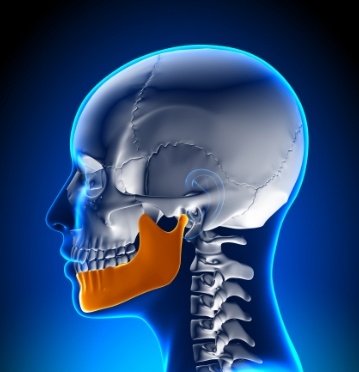
Your TMJ is the set of small hinges located right in front of your ears, and they allow your lower jaw to move freely in all directions, giving you the ability to eat, speak, laugh, and yawn. The TMJ is one of the most complicated joints in the body. But, due to a misaligned bite, teeth grinding, and other factors, it can often develop tension and chronic pain, known as a TMJ disorder, or TMD.
Signs & Symptoms of TMD

A TMD can be the cause of many symptoms that seemingly have nothing to do with the jaw. Because of the orientation of the oral and cranial muscles, tension can easily radiate from the jaw into the head or neck. In addition to pain, a jaw that excessively clicks or pops when moving, or becomes stuck opening or closing, may also indicate a TMD. Of course, the most telling symptom is pain, which can fall into multiple categories:
Symptoms Can Be Hidden In Plain Sight

One reason that TMDs (TMJ disorders) are often overlooked for a long time is that many of the symptoms they cause don’t seem to have anything to do with your jaw. You would naturally expect there to be pain in your jaw joints, of course, since that is where the issue is located; however, the way that the oral and cranial muscles are positioned means that the tension caused by TMD can radiate into the rest of the head or the neck. Dr. Jariwala can go over potential symptoms of TMJ disorder at our Albuquerque, NM dental office in order to help you determine the true cause of your pain.
Headaches & Migraines

Did you know that the jaw pain caused by TMD can sometimes be mistaken for a tension headache or a migraine? It might sound odd, but in fact, the TMJ has a direct connection with the muscles in the rest of your head; problems with the jaw joints can cause these muscles to become tense, knotted, or even damaged, which can ultimately result in chronic headaches. Because headaches and migraines can have various causes, people often don’t even realize that they’re linked to a TMD at first. If you’ve already seen a doctor about your headaches but haven’t been able to narrow down a cause, it may be a good idea to schedule an appointment with Dr. Jariwala to see if it’s a problem with the TMJ.
Ear Pain & Tinnitus

The TMJ is located right in front of your ears, so naturally any pain or inflammation in the joint could also affect the ear. This can lead to persistent earaches, and it can also cause tinnitus, which is the term for an apparent ringing in the ears. In extreme cases, a TMD can even result in hearing loss. Like headaches, ear pain is often overlooked as a potential symptom of TMD because people think the issue is an ear infection or a similar problem, when in fact the underlying issue isn’t located in the ear at all.
Face & Jaw Pain

Of course, one of the more obvious signs of a TMD is stiffness and pain in the jaw. The pain can take a variety of forms. Sometimes it’s a chronic yet dull ache while in other cases your jaw might feel fine while you hold it still but then cause a sudden, sharp pain when you try to move it. In many cases, a TMD can also affect the TMJ’s ability to move properly, which can make chewing more difficult. You might also experience lockjaw when moving your mouth, causing your jaw to become frozen in position and preventing you from opening your mouth particularly wide. You need to seek TMD treatment as soon as possible if you don’t want these symptoms to grow worse.
Bruxism (Teeth Grinding)

There is a link between bruxism (involuntary grinding of the teeth at night) and jaw pain. Sometimes the constant grinding is the cause of a TMD, or at the very least it can make an existing TMD worse. In other cases, bruxism is actually a side effect of a problem with the jaw joint, leading to a vicious cycle where bruxism and TMD are constantly worsening each other. In order to effectively treat a TMD, the effects of bruxism need to be identified and properly dealt with.
Risk Factors of TMD

The truth is that everyone can potentially develop a TMJ problem, but several common risk factors for TMJ disorders that our Albuquerque, NM dental patients should be aware of. By knowing them, you can actively work to keep yourself healthy and pain-free, and if you do develop TMD (TMJ disorder) symptoms, you can act fast to get the treatment you need. If any of the following apply to you, be sure to keep reading this page until the end.
8 Common Risk Factors for TMJ Disorders

- Gender: Numerous studies have shown that women are much more likely to develop TMD compared to men.
- Age: The older you get, the more likely you are to develop chronic pain and joint problems, and this includes your jaw as well. This is why a large proportion of those with TMD are over 40.
- Genetics: If members of your family have experienced TMJ problems, you are more likely to as well. A genetic predisposition to stress, inflammation, and abnormal jaw growth can all potentially lead to TMD.
- Arthritis: Your TMJ can develop arthritis just like your knees or shoulders. For people who already have osteoarthritis or Rheumatoid arthritis somewhere else in their body, they have a higher chance of developing it in their jaw as well.
- Bruxism/Teeth Grinding: Teeth grinding and TMD have a cyclical relationship. A person who grinds their teeth at night can develop TMD, and at the same time, TMD can cause someone to grind their teeth.
- Jaw Injury: Whether it’s due to a fall, sports mishap, or motor vehicle accident, a jaw injury can create an imbalance in the TMJ that causes chronic pain and tension.
- Connective Tissue Disease: This condition affects the tissues like the ligaments and tendons that go between various parts of the body, and it can impact the TMJ.
- Sleep Apnea: People who have sleep apnea can develop TMD because the stoppages in breathing may cause the jaw to spasm throughout the night, which can quickly overwork the muscles and cause pain.
What You Can Do About It

What’s important to state clearly is that even if one or more of these risk factors apply to you, this does NOT mean you will definitely develop TMD at some point. It simply means your risk is slightly higher compared to the rest of the population.
While you can’t change things like your age or genetics, you can mitigate their chances of leading to TMD by simply visiting your dentist and primary care doctor on a regular basis, which will help them find and correct minor problems before they can turn into a full-blown TMD.
At the same time, if you experience common symptoms of TMD (jaw pain, problems opening and closing your mouth, frequent headaches), then you should act quickly when it comes to seeking out treatment, as waiting will only allow the issue to become worse.
We Are Ready to Help

If you believe that you’re currently dealing with a TMD, Center for Dental Sleep Medicine and TMJ of New Mexico are more than ready to help. Under the leadership of an expert like Dr. Jariwala, our team can help you find the root of your pain and address it no matter what kind of risk factors you have. To learn more about our available treatments and discuss your situation, click here to request an appointment .
Diagnosing TMD

Many factors can lead to the development of TMD—stress, teeth grinding, a crooked bite, injury, arthritis, a slipped disc, and more. We’ll closely examine your joint using the latest technology so we can see exactly how it moves and determine the proper alignment for your teeth and jaw. With this information, we can put together a personalized treatment plan that is designed to stop the pain in the short term and prevent it from coming back in the long-term.
The Process of Diagnosing a TMJ Disorder

First and foremost, we’ll need to perform a thorough examination to assess your situation. Our team will ask about any injuries, procedures, traumas, or conditions that may have damaged the TMJ. Getting insight into your health history is necessary so we can determine the best course of action moving forward.
During your appointment, we’ll check the TMJ itself along with nearby bones and the muscles in your jaw, mouth, face, neck, and head to see if there are any issues. If you have noticeable pain or tenderness in those areas, it could be a sign of an underlying problem. We might even ask you to move your jaw so we can see if it becomes locked or has limited motion.
To help our diagnosis, we’ll likely take X-rays of the face, joints, and teeth. We’ll also examine the disc of the jaw joint itself using an MRI (magnetic resonance imaging) scan. In some cases, a CT (computed tomography) scan may be required to get a more detailed view of the bones. Depending on your unique case, all of these tests may or may not be needed to narrow down your specific issues.
What Happens If We Find a TMD Disorder?
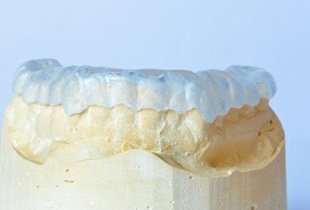
The last thing anyone wants to hear is that they’ve been diagnosed with a TMD/TMJ disorder. Although it certainly can be alarming, a successful diagnosis is a good thing! It means our team was able to identify the source of your pain and can start working quickly to provide you with relief.
If you have a mild case, you may be able to treat your symptoms on your own. You can use cold compresses, take over-the-counter pain medication, stick to a soft-food diet, and perform jaw stretches to ease your discomfort.
On the other hand, patients with more severe cases will require professional intervention. That usually means wearing a custom-made oral appliance, which holds the jaw in a certain position to relieve pressure on the TMJ. For others, it may be intended to prevent the teeth from grinding together. It’s worth noting that surgery is only recommended in the most severe cases.
Treating TMD

Once we’ve confirmed that you have TMD and have narrowed down the underlying issues contributing to it, we can put together a treatment plan to ease your pain. The answer isn’t the same for every patient; some cases are mild enough that a few lifestyle changes are enough to make a difference whereas others are more advanced and might requires surgery. Whatever treatment you end up undergoing, our team will be with every step of the way to answer questions and help you find the best path to lasting relief.
Self-Care for TMD

Oftentimes, TMD is a result of chronic stress and anxiety that causes you to clench your jaw and grind your teeth. It might also be caused by overworking the jaw joints, such as by frequently chewing gum. For this reason, self-care can often go a long way towards TMD relief, and we’re more than happy to give you a few suggestions. These tips can also be combined with other treatments to ensure that you get the best possible results.
Some of our recommendations for treat TMD on your own may include the following:
- Whenever you experience pain, apply an ice pack to your jaw joint for 15 minutes at a time.
- Pick up some pain medication over the counter and use as directed.
- Switch to a soft food diet for a while. When eating, take only small bites that don’t require much chewing.
- Perform facial or jaw stretches that help strengthen and relax the jaw.
Oral Appliance Therapy
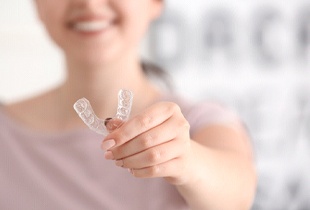
When you need professional treatment for your TMD, oral appliance therapy is a very common noninvasive solution. There are a few different appliances on the market that can be used to address specific problems, but in general, they work by adjusting the alignment of the jaw, taking some of the stress off the jaw joint so that it can rest. The appliance will also cushion the teeth to protect the jaw from constant grinding or clenching.
Once you start using your oral appliance, you may notice your symptoms gradually fading over time. Usually, it takes about 4 to 6 months of wearing the appliance to get the desired results. Some appliances are worn all day while others are worn only at night; we can give more specific instructions before starting your treatment.
BOTOX for TMJ Treatment
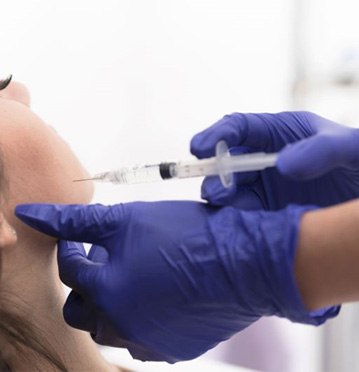
Many people think of BOTOX as a purely cosmetic treatment, and indeed, it is useful for smoothing out wrinkles. However, it can do so much more. In fact, it has some outstanding medical applications. In some cases, a person suffers from persistent discomfort because of tension in the muscles around their temporomandibular joint (TMJ). Carefully placed BOTOX injections can help those muscles to relax and provide significant pain relief. BOTOX may be a standalone TMJ treatment, or it may be combined with other therapies to produce optimum results.
What Is BOTOX?

BOTOX is the brand name for a diluted form of the bacteria that is scientifically known as botulinum toxin. When BOTOX is carefully injected into the muscles around the TMJ, it limits their movements and forces them to relax. This can reduce muscular tension and lead to significant pain relief.
A BOTOX treatment usually takes just a few minutes, and no downtime will be required after your appointment. Within 5 – 10 days, you may start to notice a significant reduction in your TMD symptoms. The results have the potential to last anywhere from 3 to 6 months.
How Can BOTOX Treat TMJ Disorder?

BOTOX has an excellent track record of helping people who struggle with symptoms of TMD. For example, one study found that BOTOX led to improvements for 90% of participants who were dealing with TMJ issues. A separate study, released in 2012, found that BOTOX decreased pain associated with mouth movements for three months after the treatment.
BOTOX is an invaluable provision for people who are looking to sleep better, eat more comfortably, and get back to enjoying a healthy, pain-free smile.
Are You a Good Candidate for BOTOX for TMJ Treatment?

BOTOX may work as a part of your TMJ treatment plan if you are experiencing:
- Pain and tenderness in your jaw.
- Lockjaw or limited jaw movement.
- Neck and back pain.
- Soreness in your facial muscles.
- Pain or difficulty while chewing.
- Ringing in your ears.
- Chronic bruxism (grinding and clenching of your teeth).
- Frequent headaches or migraines.
BOTOX is a wonderful means for providing temporary TMD relief. However, it does not address the underlying cause of TMD symptoms. Therefore, it is often combined with other treatments to produce long-lasting results.
Surgical Treatment for TMD Pain
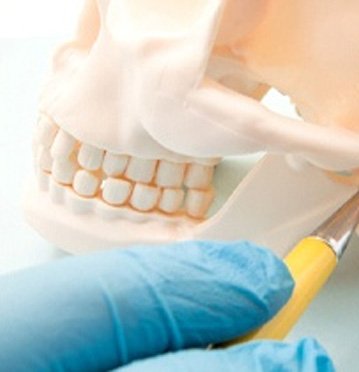
Sometimes TMD is too complex or severe to be corrected with noninvasive options, which is why surgery might be suggested as a last resort if other treatments have failed. There are different kinds of TMD surgery to choose from. The least invasive is arthrocentesis, where medication is injected directly into the jaw joint. In other cases, open-joint surgery can be performed. In cases where there’s difficulty diagnosing the problem, an arthroscopy may be recommended; this involves inserting a camera into the joint to get a firsthand look at the area and planning an appropriate treatment based on our findings.
TMJ Treatment FAQs
Our team at the Center for Dental Sleep Medicine and TMJ of New Mexico is fully dedicated to helping you put a stop to your jaw pain. If you have any questions about TMJ disorder or our options for treating it, please contact us; one of our knowledgeable team members will give you the answers you need. The following FAQs address several inquiries that we often hear from patients seeking TMJ therapy.
Can TMJ Be Cured Permanently?
In many cases, TMJ disorder can be reversed with the right type of treatment. For example, oral appliance therapy is used to correct the alignment of your jaw to take some of the pressure off your jaw joints. By addressing the underlying cause of your TMJ disorder in this way, we can potentially put a stop to your pain for good.
How Long Does It Take for a TMJ Oral Appliance to Work?
Yes, the treatments we use to address TMJ therapy are considered safe. Oral appliance therapy is a proven method of relieving jaw pain, and there is little risk associated with it. There are a few side effects that might occur, such as excessive salivation, dry mouth, tooth discomfort, and temporary bite changes. Each of these side effects should normally only last for a short time.
When it comes to surgical treatment for TMJ disorder, there’s always some level of risk involved. However, our team will take every precaution to ensure that you remain safe and comfortable during your procedure. It’s worth emphasizing that we will only recommend surgery if there’s no other option.
Is TMJ Treatment Expensive?
The price of TMJ therapy varies from case to case. It depends on many factors, such as the exact cause of your pain, the treatment we recommend, the length of your treatment course, and more. The fact is that you could ultimately pay anywhere from a few hundred dollars to hundreds of thousands of dollars to correct your TMD.
Keep in mind that although TMJ treatment can seem expensive in some cases, it is an incredibly valuable service. In exchange for your money, you are likely to find freedom from jaw pain and the other symptoms that can come with TMD, such as headaches, migraines, back pain, and more. Your quality of life may greatly improve! Also, it is important to remember that most patients can take advantage of provisions to make their care more affordable. For example, the majority of people are eligible for financing.
Is TMJ Treatment Covered by Insurance?
TMJ therapy can potentially fall under medical or dental insurance depending on the cause and the kind of treatment being performed. This is because while the TMJ isn’t considered to be exclusively related to dentistry, there are several TMJ treatments (in particular oral appliance therapy) that can only be performed by a trained dental expert.
The coverage you receive for TMJ treatment depends on what policy you have. It might also vary based on the state you live in; oftentimes insurance companies will not pay for TMJ procedures unless they’re required to by state law. Furthermore, some plans are more specific than others and only cover certain types of procedures. You should call your dental insurance provider to confirm your coverage before you begin TMJ treatment.
How Long Does TMJ Treatment Take?
The timeline for TMJ treatment varies from case to case and depends on a number of details. For example, some at-home remedies can cause immediate pain relief, but they often do not address the root cause of the problem. The pain is likely to keep returning.
A course of professional treatment that seeks to provide long-lasting relief could take several weeks or months to produce noticeable results. That may be the case with oral appliance therapy. Surgery, on the other hand, may be a relatively quick procedure. However, it may come with a significant recovery period before you can fully experience its benefits.
Is TMJ Treatment Safe?
If you turn to a qualified dentist for TMJ care, then you can expect them to adhere to the most rigorous safety standards. Our team always starts out with the most conservative options that are known to have few to no unwanted side effects. Some advanced TMD services do carry a small degree of risk, but the potential benefits far outweigh the remote chance that a treatment will cause severe adverse consequences.
On the other hand, if you do not carefully choose your TMJ treatment provider, or if you follow “hacks” that are not backed up by medical science, you could face bad consequences. There is a chance that your pain could worsen or that you might experience other undesirable outcomes.
Can TMD Be Treated Without Surgery?
In many cases, it is entirely possible to provide significant TMJ pain relief without surgical intervention. In fact, we strive to recommend surgery only as a last result because the TMJ is a complex joint, and altering it or the surrounding structures is a delicate undertaking.
Some non-surgical ways to address TMD include at-home remedies, lifestyle changes, and oral appliance therapy.
